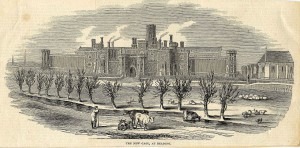
Oscar WIlde
At the time of his sentencing, Wilde was placed in Reading Prison, and after he had moved to France, the anonymous poem “The Ballad of Reading Gaol” was printed. The author was given simply as C.3.3., which stood for cell block C, landing 3, cell 3, Wilde’s cell. The poem, due to Wilde’s notoriety, could not be issued under his name. The first edition, issued on 13 February 1889, of 800 copies sold out in a week; the second edition of 1000 copies sold just as quickly. The third edition, of 99 numbered copies ‘signed by the author’ was issued along with a fourth edition of 1,200 unsigned set. It wasn’t until the 7th edition, which appeared 16 months after the first edition, that Wilde’s name was added below C.3.3. (although, if you had purchased the signed third edition, you knew very well who the author was).

Reading Gaol, 1844
The man had killed the thing he loved
And so he had to die. (Lines 35-36; 649-650)
Yet each man kills the thing he loves
By each let this be heard, (Lines 37-38)
For each man kills the thing he loves,
Yet each man does not die. (Lined 54-54)
The man had killed the thing he loved,
And so he had to die. (Lines 649-650)
And all men kill the thing they love,
By all let this be heard, (651-652)
Note the change in line 37 from “Yet each man kills the thing he loves” to the final “And all men kill the thing they love”; by the end, we are all indicted.

Jacques Ibert
Ibert composed the work in three parts, beginning first with the prison and its prisoners. An urgent motif enters, representing the murderer and his memories.
Ibert: La Ballade de la Geôle de Reading : Part 1 (Slovak Radio Symphony Orchestra ; Adriano – Conductor)
The second part is one of madness and fear, beginning with shivering strings. Two old-fashion dances, the sarabande and the gagliarde, provide the organizational thread. The sarabande, based on a 7-beat structure, throws off the rhythm due to its uneven number of beats. The gagliarde, in a more standard 6/8 time, drags everything down into despair by the end.
Ibert: La Ballade de la Geôle de Reading : Part 2 (Slovak Radio Symphony Orchestra ; Adriano – Conductor)
The third part functions as a kind of epilogue – it starts in a dark descending line, returning us to the harsh reality of the prison, but finishes in an optimistic, almost impressionist mood.
Ibert: La Ballade de la Geôle de Reading : Part 3 (Slovak Radio Symphony Orchestra ; Adriano – Conductor)
Filtered through Ibert’s French sensibility, this is a very different kind of work than if an English composer had written it. It does allow us, however, to look at Wilde’s poem in a different light – with greater depth in the horror of the prisoner’s thoughts and the situation in the prison itself.
